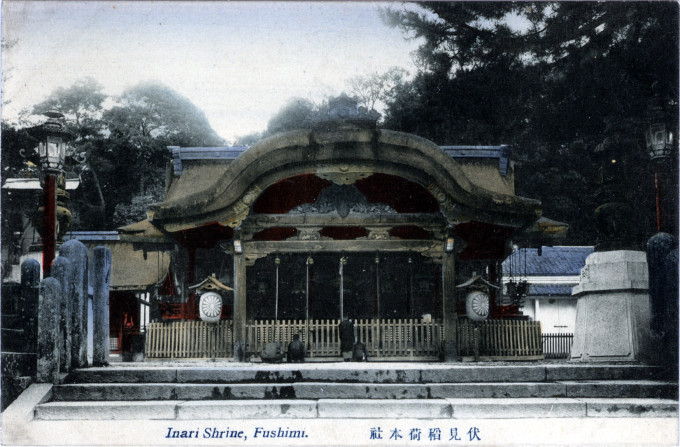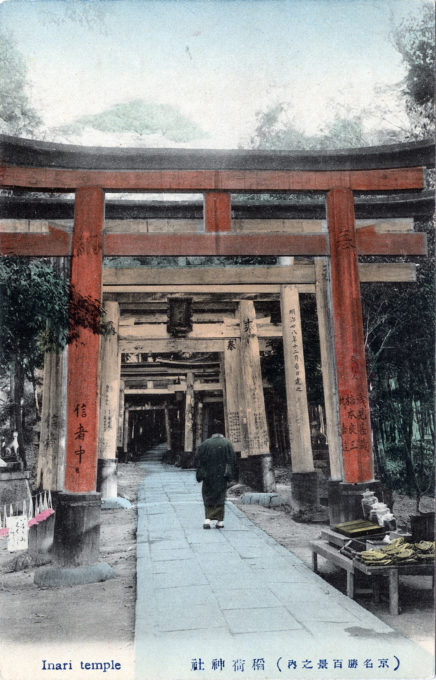“Inari: Shinto kami [god] of cereals, then of foundries and trade, as well as guardian of houses (yashikigami). Its traditional messenger is was the fox (kitsune), which came to be confused with the kami itself … A great number of shrines were built in honor Inari, whose cult, created by the immigrant Korean Hata family, went back to 711 CE.
“‘Inari’ was likely a condensed form of the word manari, meaning ‘growing rice.’ It was probably originally a kami of the fields and became a titular divinity of the Hata clan, which settled in Fushimi, near Kyoto.”
– Japan Encyclopedia, by Louis Frédéric, 1996

Inari Shrine, Fushimi, Kyoto, c. 1910. Fushimi Inari-taisha is the head shrine of the god Inari, located within the precincts of Kyoto, Japan. The shrine sits at the base of a Inari-yama, a mountain 760+ feet above sea level. Since Japan’s earliest beginnings, Inari was originally and remains primarily the kami of rice and agriculture, but merchants and manufacturers also worship Inari as the patron of business. The first shrine built on the site was constructed in 711 CE. The present-day main shrine structure was built in 1499. Each of the roughly one-thousand torii leading to Fushimi Inari-taisha itself was donated by a Japanese business.
“The fox is certainly the most influential and greatly feared of all the animals to which supernatural power is assigned by the mass of Japanese, and shrines called Inari jinsha, in which the fox is enshrined as a deity, are numberless, and to be seen in all parts of the Empire.
“Inari temple”, Fushimi, Kyoto, c. 1910. A highlight of Fushimi Inari taisha are the rows of torii known as Senbon torii [One thousand gates]. The custom to donate a torii began spreading from the Edo period (1603–1868) to have a wish come true or in gratitude for a wish that came true, with successive gates being added up to the present day by donors out of gratitude. Along the main path there are around 1,000 torii.
“It is held that the animal was not originally looked upon as a god, and is not now, except by the ignorant; but the name of the deity written in Chinese characters signifies ‘fox’, from which it came to be generally accepted that the god was really a fox, and that the animals with which they were familiar were the messengers or representatives of the real deity, and their images in wood or stone are to be found guarding the Inari shrines.
“Its natural cunning is greatly enlarged upon, and it is believed to be capable of seriously misleading or deceiving human beings; which fact, of course, brings many to pray to and placate the fox-god. Many stories and testimonies from those experiencing difficulties and inconvenience through the designs of the fox, are prevalent and accredited.”
– “Popular Japanese Superstitions”, The Japan Magazine, November 1910


